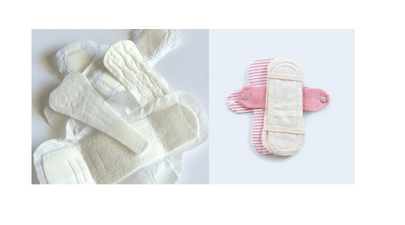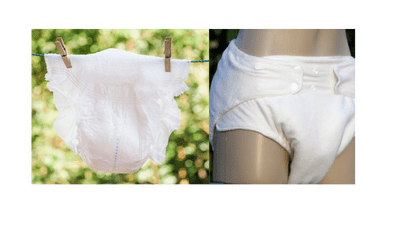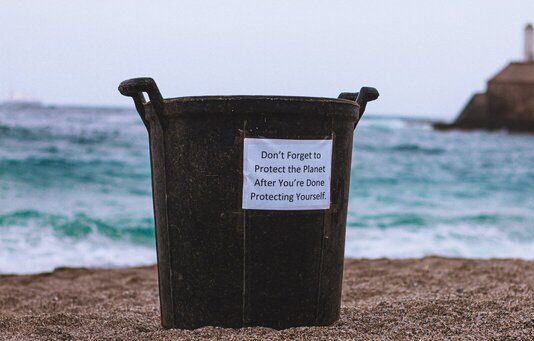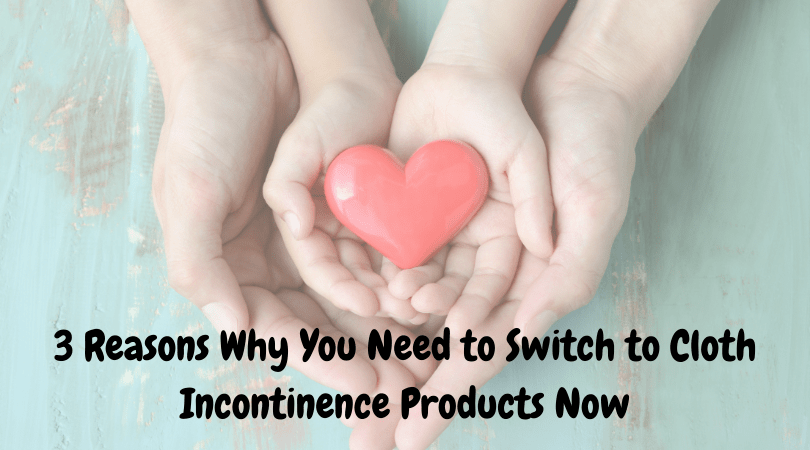While you can no doubt come up with reasons NOT to switch to cloth incontinence products (it’s a hassle, expensive, etc), there are some valid reasons to consider going with cloth that outweigh those reasons.
They are:
1. Budget friendly
2. Body friendly
3. Earth friendly
While the goal of these reasons may be to karate chop your doubts, at the end of the day, it’s more than about knowing the pros to switching to cloth incontinence products.
It’s about knowing your WHY.
1. Budget Friendly
Budget. Who knew one single word could have the power to strike both feelings of fear and freedom?
Budget is also one of the most common reasons people choose to switch to cloth.
But I get it, the upfront cost of cloth is daunting and if you were to switch all at once, you’d be paying for a full year of coverage in one go rather than monthly.

So I guess the question is, are you or aren’t you the type of person who always chooses the payment plan option at checkout?
Just kidding.
Even if you do decide that you want to switch to cloth, it doesn’t have to be an all-or-nothing, cold-turkey sort of switch.
But I’ll let the numbers speak for themselves. iDiaper, a company that sells both disposable and reusable products, has broken the cost down for disposables depending on type of incontinence and I have taken the liberty in condensing and adding to their analysis.
Cloth needs to be washed at least every 3 days. DO NOT even think about stretching this timeline, otherwise you will have to deal with smells you probably don’t want to smell. So for the below analysis of cloth needs, I am accounting for 3 days worth of cloth items.
But first a note on how long cloth products last.
iDiaper claims that their reusable products can be worn 300 times, which is not completely unreasonable since Wazoodle claims that their PUL and other fabrics can withstand 300+ washings.
In my shop, people generally come back to order more of a particular item a couple of years after they last purchased.
However, since I’m blessed to be both practical AND a realist, I know not everyone will have sterling care routines that will ensure their cloth items live out their lives like cage free animals.
Therefore, we will assume with this analysis that a 3 day stash of reusable products will last a year or 117.33 washings.
Also, because there is so much variation among cloth products, I’m simply going to average the cost.

Mild Urinary Incontinence
Mild incontinence is, well, mild. So light coverage is needed. Since we’re talking mild incontinence for light bladder leaks and stress incontinence, we’ll estimate 2-4 pads per day and so do our analysis for 3 per day if pads are used (both cloth and disposable) and 2 per day if underwear is worn.
Disposable pads: $.25 per pad, $23 per month, $274 per year.
Disposable underwear: $.87 per item, $53 per month, $635 per year.
Cloth pads: $10 per item, $90 per month, $90 per year.
Cloth (briefs/panties): $35 per item, $315 for supply, $315 for year (3 items per day/9 item stash).
Moderate Urinary Incontinence
Most people who suffer from moderate urinary incontinence use an average of 2-4 diapers a day.
Higher quality disposable: $1.31 per item, $80 per month, $960 per year (for 2 items a day)
Cost effective disposable: $.85 per item, $50 per month, $620 per year (for 2 items a day).
Cloth (pull ups/briefs/panties): $35 per item, $315 for supply, $315 for year (3 items per day/ 9 item stash)

Full Urinary Incontinence
With full urinary incontinence, items should be changed each time to protect skin health. iDiaper estimates that most people dealing with full urinary incontinence use 3-4 diapers during the day and 2 at night for an average of 4-6 diapers a day.
A note of full urinary incontinence: night time and day time needs require different products in this realm. We will go with 2 overnight products and 4 daytime cloth ones.
Higher quality disposable: $1.31 per item, $197 per month, $2390 per year (5 items per day)
Cost effective disposable: $.96 per item, $146 per month, $1752 per year (5 items per day)
Overnight cloth product: $50 per item, $300 for supply, $300 per year (2 items per night, 6 item stash)
Daytime (heavy absorbency pull up/diaper): $40 per item, $480 supply, $480 per year (4 items per day, 12 item stash)
TOTAL Cloth cost: $780 per month, $780 per year
Please keep in mind that these numbers are averages. So many options exist in both the disposable and cloth realm that the numbers can vary drastically.
If you prefer to do your own cost analysis, you can check out Baby Tooshies calculator. Obviously, it’s meant for comparing the cost of baby cloth vs. disposable diapers, but you can still input the numbers from whatever products you’re using or are interested in using to see the total cost without having to go through all the math yourself.
2. Body Friendly
Caregivers often come to me looking for advice about switching to cloth due to frustrating rash issues. As we age, our skin weakens, making the nether regions more susceptible to rash. Of course, a person could always slap on a thick layer of ointment, but that stuff’s kinda gross and doesn’t really feel like a long term solution.
Of course, to be fair, if you switch to cloth and start using plastic, nylon, or vinyl covers, that lovely diaper rash may not go away after all.
Why?
Because rash occurs in the first place due to skin contact with moisture, lack of airflow, with some bacteria thrown in the mix.
Plastic, while superb at keeping moisture in, is no good for airflow. Luckily, PUL and polylaminate materials, as well as wool, when used as the waterproof barrier in a cloth incontinence item still allows for air flow and the skin to breath.
Also to consider is how you feel when wearing cloth vs. disposable. I don’t mean this in the ABDL sense because that’s not what this is about. Though if that’s your jam, rock on.
This is about you and your confidence in your body. When you feel comfortable and confident in your body, you are going to live a better quality of life. You deserve that and the world deserves to see the best version of you.
Plus, cloth is soft. I once had a customer write me a review about a bamboo fleece item stating,
“It’s so comfortable that it’s like wearing a cloud or snuggling up with your favorite soft blanket on a cold rainy day.”

The Takeaway
Disposable products aren’t exactly kind to skin since the plastic can trap moisture and cause chafing and rash. In addition, some cloth diaper covers can still cause rash.
However, with all the cloth options available, finding something that is comfortable, going to meet your needs, AND doesn’t feel like a diaper, has never been easier.
3. Earth Friendly
Now, if you’ve ever undertaken the time for some tedious research on the merits of cloth vs. disposable, no doubt you’ve come across conflicting information.
The truth is, much of our information is bought and paid for by corporations that have a vested interest in a study having a specific outcome. I say this not to be political, but simply because that’s the way it is.
For example, if a disposable diaper company pays a whole lot of money for a study looking at the cloth vs. disposable diaper question, I’m going to take a gander that if the outcome of that study puts cloth ahead of disposables, somebody’s not going to be happy.
Anyway, let’s take a moment to compare the facts. Please note that I’m using “diaper” very loosely, as there are a ton of cloth incontinence options that do not tread on the dreaded diaper territory, but most studies on this issue tend to stick with the effects of baby diapers.
One study undertook this question by analyzing the life cycle of disposable vs. cloth. They do a pretty good job presenting both sides of the equation.
Basically, they cover these themes: material resources, water and electricity use, and pollution.
-
Material Resources
The absorbent portion of cloth diapers are made primarily from cotton, bamboo, or hemp, which are renewable resources. Of course, cotton has its issues with pesticide and water requirements, but bamboo and hemp grow quickly and require little pesticides and water.
However, we must acknowledge that PUL uses polyester, which is a petroleum product. Actually, with the exception of wool and latex, all waterproof fabrics used in cloth diapering use petroleum. Unfortunately, this fact is almost never cited in comparison studies. Which I don’t get, because seriously, what good is a cloth incontinence item without a waterproof barrier!?
Disposables, on the other hand, rely on two main resources for materials: wood and oil.
While you could claim that trees are a renewable resource, if you compare the time it takes for them to grow to the time it takes for cotton, hemp, or bamboo to grow….Considering too, the rate of deforestation, wood pulp while MUCH better than superabsorbent polymers (yay for clogging up waterways!), is not a sustainable alternative.

-
Water and Electricity
Ah, the great water debate! Who’s responsible for using more! *angry face*
Whew! The sibling rivalry of cloth and disposable makes me want to edge away quietly into the dark and wish that there was an elimination communication version available for incontinence. Though if there was, I guess it wouldn’t be called incontinence….
Anywho, water and electricity.
Most studies agree that cloth uses more water and electricity over their lifespan than disposables.
However, this variable is highly variable depending on how you wash your cloth incontinence products. For example, High Efficiency front loading washers use significantly less water than top loading washers.
Same goes with drying. If you line dry, you don’t use as much electricity. Although line drying can be inconvenient at times, not to mention, not discreet.
The Life Cycle Initiative has a nice chart on page 7 of their report that compares the impact of a consumer’s lifestyle choices in using cloth vs. disposable.
-
Pollution
Both cloth and disposables require the use of less-than-lovely chemicals in both the manufacturing and use of the products.
Cotton uses pesticides and fertilizers and if you’re really going to be a stickler, there are chemicals in laundry detergent.
Disposable diapers use chemicals like dioxins, furans and chlorophenols, solvents, sludge (why does that sound scary!?) and additional heavy metals.
When it comes to air pollution, disposables have a high carbon footprint, but the electricity needed to launder cloth cancels out the difference. Though to be fair, the uh, quality, of chemicals that the manufacturing process of disposables release into the air is a little more sketchy than cloth.
The Takeaway
Alas, cloth is not the clean angel of eco purity.
The good news is, the ecological impact of cloth incontinence products comes down to personal behaviour and choices both in the material realm (cotton, bamboo, hemp, etc) and in how you wash (type of washing machine, detergent choice, drying, etc).
With cloth, YOU are in control of your environmental impact.
Wow. That is a lot to take in.
At the end of the day, the choice to use cloth incontinence products requires the weighing of several variables.
So take a moment to ask yourself why you want to switch. Do you want to be more conscious of the waste you create and find a greener alternative to disposables? Or maybe you want to save money or find a better way to deal with rash and chafing that you or someone you’re caring for is experiencing.
Regardless of your reasons, knowing your why will set you up for success in switching to cloth incontinence products for the long term.
Additional search phrases associated with this article: pros and cons of cloth diapers vs. disposables for adults, is disposable better than cloth for adults?, is it cheaper to use cloth diapers or disposables?, are cloth diapers really worth it?, adults wearing diapers for comfort, adults wearing cloth diapers, reusable vs. disposable diapers for adults
Alecia
Latest posts by Alecia (see all)
- Why Little Onion is Not ABDL - November 1, 2024
- Best Adult Diaper Covers - March 7, 2024
- Best Fabrics for Making Adult Diaper Covers - February 16, 2024


